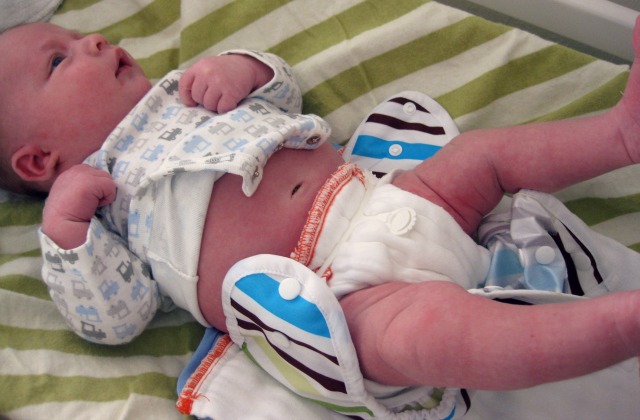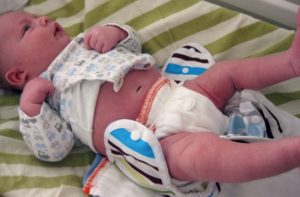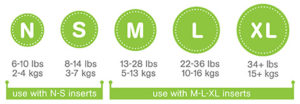
Cloth Diapers Buyers Guide – Covers
There are a ton of different types of cloth diapers out there. Every time I think I know them all, some manufacturer comes out with their own style. For a newbie, the thing to remember is that cloth diapering rests on the fact that layers are needed to absorb. Covers are similar to the more traditional cloth diapers our mother’s remember; however, new fabrics and technologies mean they’ve slimmer and more efficient than every. Here, I’ll cover a higher price and lower price option as well as a hybrid alternative.
Flats, Prefolds, and Covers
Covers are a two part “system”: an absorbent interior, usually made of cotton (either a flat or a prefold), with a reusable waterproof outer shell that covers the interior (the cover). To many of our mothers and grandmothers, these may seem the most like the classic white cloth diapers with pins and rubber pants, but they’ve come a long way baby.

We’ll get to the actual cover in a moment, but first let’s address the absorbent inside of the diaper. There are two main options here: flats and prefolds. Flats are large cuts of flat cotton that need to be folded into a diaper shape. While there are two or three main folds depending on male, female, and infant or toddler, there are tons of other folds and options out there to suit different needs. If you have a tummy-napping toddler, you can fold it to get more absorbency in the front and then use a different fold for when she’s running around after her nap to relocate the absorbency to the middle and back. Heavy wetters can use two flats or wrap their flat around an extra instert, while side sleepers can have folds that cover their sides from leakage. You can buy flats, make them from raw cotton, or make them from thrift-store t-shirts (which I think is pretty awesome).
“I don’t have the time to learn and do all that folding.” The alternative to flats are prefolds. Prefolds are exactly as the name sounds: the diaper is sewn into a prefolded shape that you just put on baby. While it means you don’t have as much flexibility, it also means you don’t have to spend a half hour folding diapers every week. I think an ideal stash might include a few of both to allow you extra flexibility to respond to a variety of different situations.

“I’m not comfortable using safety pins on my baby.” Safety pins are the thing of the past. Most prefolds and flats use plastic fasteners (see the side picture of snappis). Alternatively, some flat users use an origami folds that allows the ends of the diapers to be tucked into and held in place by the diaper itself.
A popular alternative to prefolds and flats is simply using flour sack towels (fst). Yes, those same towels you have in your kitchen for drying dishes are extremely popular in cloth diapering circles. Made of soft and absorbent cotton, they’re often a fraction of the price of purpose sold cloth diapers. You can stock up on fst’s at Walmart when they’re on sale for around $.50 to $1 a towel.
Another budget-friendly alternatives if you can sew is to cut and serge old cotton t-shirts into great flats. You may have old shirts at home, or can pick them up from Goodwill or second-hand stores for a quarter a shirt.

The Cover
The last part of the diaper is the waterproof exterior, the cover. Like nearly all of the other diaper I’m writing about, the cover is lined with a layer of water resistant PUL – a polyethylene coating. PUL is thin and light and allows the diaper to contain liquids without adding bulk. While not waterproof, it does repel liquid as long as baby is changed regularly. Covers can be reused several times and simply wiped down in between uses until they become soiled. Heavy wetter babies can have additional padding tucked into their cover. Lastly, covers come in a variety of patterns and colors which can become a pursuit to collect in themselves.


How much does this cost? Does it really save me money?
For price, I’m going to omit nighttime diapering which I’ll address in a separate post. Cloth diapers need to be changed on a 2 hour schedule: assuming babies are awake 12 hours, that’s 6 diaper changes a day, but I’m going to account for 7 for those non-schedule poos.
High End: $326.90 total, or $.36 a day (assuming you cloth diaper for 2.5 years). An informal poll of my friends revealed they spent about $40 a month on diapers. Therefore, Covers will pay for themselves in a little over 8 months, even at the high end level!
My Math: 7 prefolds a day at $1.25 per prefold = $8.75. Multiply that by 7 days a week (because I’m assuming if you’re going with high end covers you’ll buy enough to get through the week), and you get $61.25 for the prefolds. Add $14 for the Snappis = $75.25. I’m averaging that you’ll use two Blueberry covers (at $35.95 for a two pack) a day for 7 days at a total cost of $251.65 for the covers. That plus $75.25 equals $326.90.
Budget Conscious: $85 total, or $.09 a day (assuming you cloth diaper for 2.5 years). The absolutely cheapest diaper I could find was $.08 per diaper. Therefore, Alva Baby covers will pay for themselves in about 4 to 5 months.
Showing My Math: A good average price for the Walmart FST is $.75. If you’re most budget conscious, I’m going to assume you’ll wash more frequently, so you’ll need 28 prefolds to go 4 days between washing, that’s $21 put $14 for the Snappis is $35. Two packages of Alva baby covers cost of $50 (though you might be able to get by with one six-pack). That’s a grand total of $85.
To see what other costs you’ll incur getting up and running with cloth diapering, click here.
gDiapers

gDiapers are a somewhat new alternative to a flat and cover. Similar to a cover, an absorbent interior is used with a reusable cover called a “gPant”. However, gDiapers use an interior “pouch” that holds an fabric or disposable insert rather than a flat or prefold. The insert is thrown out after every change, just a flat or prefold. The pouch is attached to the cover and each can be reused until they become soiled. The pouch is the water resistant part and can also be wiped out if wet. The genius of the system is that the inserts mean that you don’t need to know any folds or use safety pins or snappis. The exterior cover uses velcro which allows for easy changes.
This is a great system for kid that will be in day care or have babysitters because it’s very straight forward and easy to learn. Because of the reusable cover, it’s also saves space compared to AIOs or pockets, which makes it easier to pack up and send to daycare or take on vacation. Speaking of vacation, gDiaper also sells disposable inserts, too. I keep a few extra in the car and diaper bag for “those days” when I need an emergency stash.
The Bottom Line
gDiaper shells sell for about $13.50 to $15 each. A box of 6 cloth inserts sells for $33. So, to diaper 7 days with six changes a day, you’ll spend $325. Obviously, you can cut down your costs significantly by washing more than once a week, but this gives you a general guide. On the surface, these appear to be equivalent to the high-end covers I priced out. The big caveat, however, is that these diapers and inserts come in sizes.

If you are buying everything new, gDiapers can be a big investment: potentially as high as $880. At that rate, you’ll have to wait until 23 months to recoup your costs compared to disposables. There are ways to economize, of course. Charlotte outgrew the small diapers around three to four months, so they were very light used. I’ve since lent them to two other moms, meaning they didn’t have to buy newborn or small diapers or inserts. Charlotte has now been in the mediums for a year. Based on the weight, she’s still a ways a way from moving up to large, so I’m hoping that she’ll potty train before she needs the large size. Regardless, the pouches take the brunt of stains and the different sizes mean they wear lightly, so eventually I should be able to sell them and recoup a good part of my investment.
An additional feature of gDiapers is the disposable/compostable inserts. The website will promote these as the preferred insert. The price, however, is steep. At around $50 for a pack of 128, they break down to $0.39 each – nearly twice as expensive as a regular diaper. I’m not exactly sure who these are a best fit for, but I’m sure I’m not it.
So, there is a break down of covers and a popular cover hybrid.
